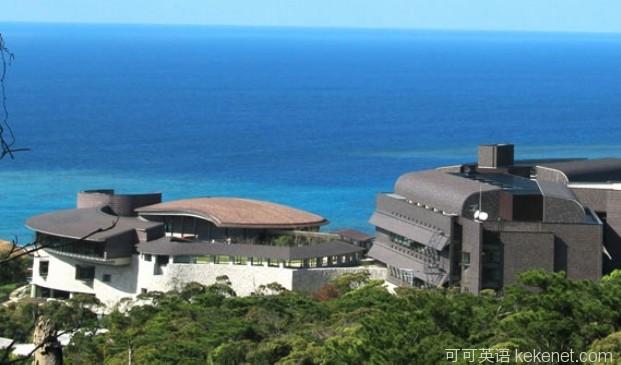(单词翻译:单击)

Science and Technolgy
科技
Science in Japan
日本的科学界
Where rats and robots play
才学通修
Japanese science needs a shake-up. A new institute in Okinawa may provide it
日本的科学界需要一场变革。在冲绳,一所新的学院为这一变革提供了条件。
THINK of a university and what comes to mind may be the cloistered calm of Oxford, the architectural chaos of MIT or even, perhaps, the 1950s brutalism of Moscow.
谈到大学,你可能想到宁静致远、与世隔绝的牛津大学,也可能是建筑风格混杂的麻省理工大学,更甚至是50年代莫斯科的那种粗狂主义。
A Daliesque building on a subtropical island, with a view of the ocean and signs on campus warning of venomous snakes, is more unusual.
一座亚热带岛屿上,可以望到大海,同时也可以看到毒蛇的警告的标志。
But that is appropriate, for the Okinawa Institute of Science and Technology (OIST), inaugurated as a graduate university on November 19th, is intended to be unusual.
就是在这样一个地方,达里艺术风格的建筑就显得格外不同。冲绳理工学院(OIST)不走寻常路的理念也适合这种风格。这所研究生学院正准备在九月十九号开学。
It was built from scratch on a forested hilltop overlooking the East China Sea, and its approach to science starts from scratch too.
这座建筑坐落于丛林密布的山顶,从山顶上能够望见中国东海。
It has no departments. Instead, its biologists, chemists, physicists, mathematicians and computer geeks intermingle, sharing laboratory equipment, teachers and money.
而其对于科学的探寻也将从此开始。这所学校没设院系。生物学家、化学家、物理学家、数学家和电脑专家会打破界限,分享实验仪器,教学资源以及资金。
After two centuries of science becoming more and more specialised, the idea is to bring back the generalist.
200年来,科学变得越来越往小门类发展,而冲绳理工学院却意在重回通才教育。
Surprisingly, this experiment is taking place in Japan-a country with one of the most rigid academic hierarchies in the world.
令人惊讶的是,这次改革试验也发生在世界学术界最古板的国度之一日本。
Locating it in Okinawa, though, is a masterstroke.
其中把学校设在冲绳,也是个妙招。
The island, which is closer to Shanghai and Taipei than to Tokyo, is as cut off as is possible to imagine from the mainstream of Japanese academia.
因为冲绳岛相对东京,离上海和台北更近,这样就可以不受日本主流学术流派的影响。
The result is a skunk works: a place where novel and possibly controversial ideas can be tested without constant interference from institutional vested interests.
在OIST,师生可以对新奇的和存在有争议的观点进行测试,而且不会因为制度上的既得利益问题而受到不断干扰。
If an idea from a skunk works fails, it can be buried quietly, and nobody gets hurt.
如果创新小组的点子、想法没能成功,失败就会被静静地掩盖起来,没有人会因此受到伤害。
If it succeeds, it can be launched fully formed, and bureaucratic resistance thus overcome.
如果观点成功了,观点就可以成为现实,这样做就克服了来自官僚制度上的阻力。
The OIST certainly has the money to do this.
当然OITS也有足够的资金来完成这些新举措。
The government has spent ¥77 billion (almost $1 billion, at current exchange rates) over the past six years to create it.
在过去的六年中,政府拨款770亿日元来建立学院。
It has the personnel: 212 researchers, and five Nobel laureates on its board of governors.
212名研究员在OITS任职,并且其中5为董事会理事曾获诺贝尔奖。
Soon it will have the students, too.
不久,学校就会招收学生。
The first intake, next autumn, will only be 20.
时间定于明年秋季,第一批大约只有20人。
But that will rise to 100 in five years' time.
但是,五年之后人数会升至100。
According to its president, Jonathan Dorfan (a physicist lured from Stanford University), the OIST seeks to address three shortcomings in Japanese science.
根据校长乔纳森?多芬(从斯坦福大学挖来的物理学家)的介绍,OITS意在解决日本科学界的3根"软肋"。
First, it wants to nurture independence of thought in young researchers, encouraging them to work for themselves rather than as foot soldiers for professors.
首先,要培养年轻学者的独立精神,鼓励年轻人按照自己想法行事,而不是跟在教授们后面,成为他们的走卒。
Second, it wants Japanese science to become more open to the outside world.
其次,也希望日本科学界更加与国际接轨。
Third, it wants to stimulate the emergence of technology clusters in a country where there is disturbingly little interaction between universities and industry-and few Silicon Valley-style start-ups as a consequence.
第三,通过学院促进日本技术的研发。在日本,高校和产业间的联系比较小,因此很少看见想硅谷这类企业模式。
That graduate students and post-docs are fodder for the ambitions of departmental heads is not unique to Japan.
在日本,研究生和博士后都非常渴求成为该领域的领军人物。
But the phenomenon is generally thought to be exaggerated there: a toxic consequence of Confucian respect for authority and an academic system borrowed lock, stock and barrel from 19th-century Germany.
然而,这一现象似乎被夸大了:十九世纪日本曾向德国学习。而这种照单全收的学习也产生了不良的后果——对于权威和学术体制一种盲目的崇拜。
Young Japanese researchers, though, are fed up with it.
日本的青年学者也对此十分厌恶。
One result is that the number of graduate students in natural sciences has been falling in Japan since 2003.
这也造成了自2003年以来,自然科学的研究生数量减少。
Those youngsters are, nevertheless, oddly reluctant to deal with their disgruntlement by going abroad.
然而,年轻人也不太想通过出国留学解决不满的教育现状。
Between 1996 and 2007, 28% of the science and engineering doctorates awarded in America went to Chinese; 11% to Indians; 9% to South Koreans; and 7% to Taiwanese.
1996年与2007年之间,28%在北美毕业的科学和工程博士是中国人。这一数字在印度、韩国、台湾分别是11%、9%、7%。
Japanese, by contrast, picked up just 2% of them.
相反,日本仅占到了其中的2%。
That stymies the exchange of ideas on which good science depends.
这也妨碍了观点的交流,而这对于科学来说是至关重要的。
If young Japanese scientists cannot be persuaded to study abroad, though, perhaps abroad can be brought to Japan.
既然日本的科学家不太愿意走出国门,那么,是不是把国外的教育理念引入日本国内。
At the moment, 85 of the OIST's researchers are gaijin.
OIST的85名研究人员来自国外。
Ultimately, the organisation aims to recruit half of both its faculty and its students from outside the country.
到最后,从国外招募的研究员和学生的数量会占到总数的一半。
And, as if that were not enough to stir the pot, these scientists have to mix with each other, too.
如果以上还达不到人们的预期,学校还会这些科学家要融合彼此、进一步进行沟通交流。
The OIST's laboratories (designed by Kenneth Kornberg, the son of a Nobel prize-winning scientist and brother of another) abut one another and share microscopes, refrigerators and other equipment.
OITS的实验室把每个人组合起来——共享显微镜、冰箱和其他实验仪器。
Dr Dorfan says everything is designed to eliminate the barriers—physical and otherwise—between traditional fields of research.
Dorfan表示他们做的每一件事都是为了消除障碍,无论是物质上还是是传统研究领域所引起的。
That breakdown of barriers is even apparent in individual researchers.
而个人研究中,打破这种障碍比较明显。
Kenji Doya, for example, is an engineer turned neuroscientist.
举例来说,Kenji Doya,原先是一位工程师,之后成为了一名神经学家。
He runs two laboratories at the OIST.
他在OITS运行2家实验室。
One explores learning by robots.
其中一家探索机器人。
The other looks at how a brain chemical called serotonin regulates the patience of rats.
而另一个则是研究大脑中的一种叫血清素化学物质如何调整老鼠的耐受力。
An algorithm for regulating patience in the brain, he believes, could be used to improve robotics.
他认为这种在大脑中调整耐受力的运算法则可以用来改进机器人学。
Which is just the sort of thing that, if brought to fruition in Dr Dorfan's alma mater, would have the researchers who had come up with it bolting out of the door and into the offices of the nearest venture capitalist, prior to hiring a suitable garage to build their prototype in.
还有另外一种可能,如果在Dorfan博士的实验室中取得一些成果,会不会有研究员夺门而出来到最近的风险投资处,之后就找一个合适的工厂来制造样品。
Whether that will happen in Okinawa, remains to be seen.
这些是否会发生在OIST,还不太好说。
Its physical climate is certainly as pleasant as California's.
不过OITS的学术氛围会像加州一样的轻松。
Changing the intellectual climate to match may prove a challenge.
当然这也是具有挑战的,毕竟它改变地方的学术气候。


